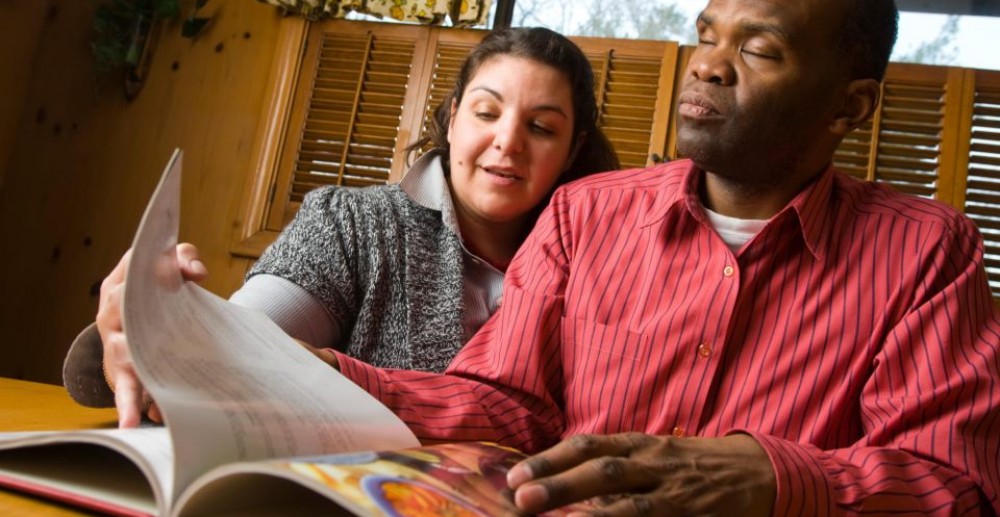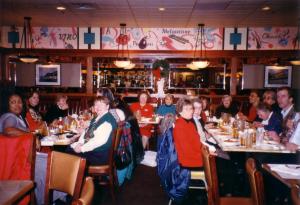Introducing Team With A Vision member Ray Charbonneau…
The 2013 Boston Marathon was my 22nd marathon and my fifth Boston. This time I didn’t have a number. Instead, I ran with race bibs pinned front and back, reading:

I ran as the guide for visually-impaired runner Mike. Mike’s sight is limited to a narrow window directly ahead of him, a condition called retinitis pigmentosa. We ran tethered together, holding on to opposite ends of a necktie Mike had borrowed for the occasion.
We spent the first mile slowly picking our way through the thick crowds while we worked out the details. The tether worked better if there wasn’t a lot of slack, so we ran side-by-side with less than a foot between us. That meant we bumped arms frequently, but the contact helped us keep track of each other’s location.
Once we had a little room, Mike starting turning in sub-9 minute miles, well under the 9:40s he’d need to finish at his stated goal of 4:15. We were passing people more often than we were being passed, so I was constantly scanning the runners ahead of us, looking for spaces wide enough for two people to fit through. When I saw something, I’d call out the direction and either tug on the tie or give Mike’s arm a nudge. When we were lined up properly, I’d say okay, give the opposite signal to stop our sideways motion, and we’d move through the gap.
 As we got more comfortable running together, we got a little more aggressive. Sometimes Mike would see a gap ahead of him and he’d go for it, but since his field of vision was narrow, he wouldn’t realize that the gap wasn’t quite wide enough for the two of us. There were a few times I had to hold him back, but for the most part I just fell into line behind him until we made it through. Then I’d accelerate to get back to his side.
As we got more comfortable running together, we got a little more aggressive. Sometimes Mike would see a gap ahead of him and he’d go for it, but since his field of vision was narrow, he wouldn’t realize that the gap wasn’t quite wide enough for the two of us. There were a few times I had to hold him back, but for the most part I just fell into line behind him until we made it through. Then I’d accelerate to get back to his side.
Once I realized Mike wanted to go for it, I started leading him through those gaps, darting into his field of vision and calling, “Follow me!” We’d shoot through, I’d slow down for a few steps so he could get back to my side, and then I’d start looking for the next gap.
Mike only had two collisions, both early in the race when runners directly ahead of us decided to stop suddenly. The first person was just oblivious (and wearing headphones), while the second had stopped to pick up a sweatband that another runner had discarded. In both cases Mike let me know he was okay and we got right back on track.
It was a warm spring day, and it got warmer as the race went on. By the time we reached Wellesley, I was sweating profusely and I had to throw water in my face to rinse the salt out of my eyes. Even Mike, used to the warmer weather in Texas, was getting a little too hot.
Luckily, a cool sea breeze started to provide some relief as we approached the Newton hills. All of Mike’s previous marathons were on flat courses, so the series of four hills in Newton between mile 17 and 21 would be a big challenge for him.
We rolled up the first two hills, passed the Johnny Kelly statue, and climbed the third hill. When we reached the top, I told Mike that the worst of it was over. Then we hit Heartbreak, which looked to Mike, “like a wall of people on a giant escalator.” Halfway up he was struggling, but he had enough breath to complain that I’d said this would be “just a bump.” I cheerfully admitted that I might have lied.
Once he crested Heartbreak, Mike sped up again, determined to finish strong. Whenever there was some space, he’d jump ahead, forcing me to accelerate to catch up. I was starting to get tired. Each time I had to break into a run to chase Mike down, in the back of my mind I wondered if I could do it. Happily, I answered the call every time.
As we zoomed along, we caught up with a slower woman runner so quickly that I didn’t have time to decide whether to go to the left or to the right. Instead, I shouted, “Up!” By this time we were working so well together that we both instantly raised our arms, split, and went around her on either side, our arms still connected by the necktie passing cleanly over her head. As Mike noted later, it was a good thing she was short.
I was furiously doing math in my head as we ran. At mile 24. I realized that if we were able to finish strong, we might just sneak in in under four hours. Mike somehow increased his effort to meet the challenge.
Then we turned right on Hereford, left on Boylston, and Mike sensed the finish. He found a clear path down the middle of the road and charged for the line with me running alongside, struggling to keep up. Unfortunately, the reason there was a clear path was because there was a large group of cameramen in the center of the road. Most runners went to one side or the other to avoid them but Mike crashed right through with me trailing behind, thankful that we didn’t hit anything.
of the road and charged for the line with me running alongside, struggling to keep up. Unfortunately, the reason there was a clear path was because there was a large group of cameramen in the center of the road. Most runners went to one side or the other to avoid them but Mike crashed right through with me trailing behind, thankful that we didn’t hit anything.
Mike crossed the line with a chip time of 3:58:47, placing him 11th in the Visually Impaired division.
————-
This post was written by Ray Charbonneau
 Ray Charbonneau is the editor of The 27th Mile. The complete version of this article is included there, along with works from Amby Burfoot, Lawrence Block, Kathrine Switzer, and more runners who write. Proceeds from sales of The 27th Mile go to benefit The One Fund Boston. For more information, visit the27thmile.com.
Ray Charbonneau is the editor of The 27th Mile. The complete version of this article is included there, along with works from Amby Burfoot, Lawrence Block, Kathrine Switzer, and more runners who write. Proceeds from sales of The 27th Mile go to benefit The One Fund Boston. For more information, visit the27thmile.com.















